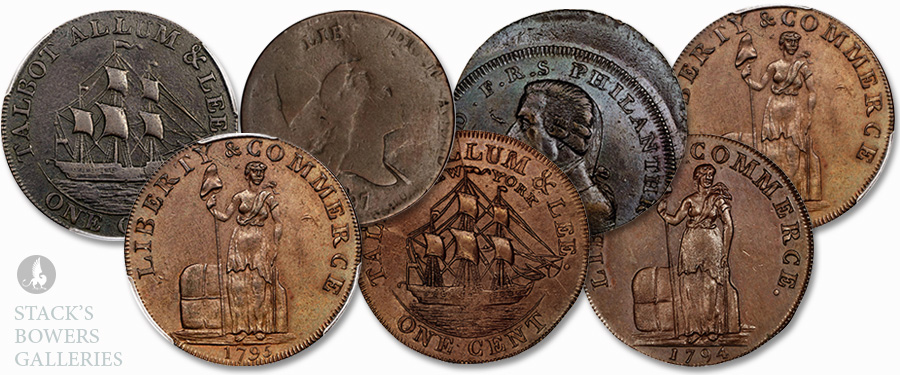
In the 1790s the fledgling United States Mint was casting about for the metal it desperately needed. One source of copper was Talbot, Alum & Lee, a New York-based East India trading company partnership established in 1794 that contracted with Peter Kempson’s mint in Birmingham, England to produce thousands of copper one cent tokens, roughly the size and weight of a British halfpenny. These tokens were used to strike cents and half cents from 1795 to 1797. The Sydney F. Martin Collection included many of these issues, which will be offered for sale in Part III of our sale of this legendary collection, which will take place March 20, 2023, the first session our Official Auction of the Whitman Coin & Collectibles Spring Expo.
Liberty appears on the tokens’ obverse in front of a large parcel holding a staff topped by a liberty cap with the words “LIBERTY AND COMMERCE” arcing above her and the date below. The reverse depicts a merchant ship surrounded by the firm’s name, “NEW YORK,” and the denomination. Edge lettering reads “PAYABLE AT THE STORE OF.”
In 1795, the firm sold more than 50,000 of the tokens to the United States Mint for use in coining copper cents and half cents, though the latter was the only issue for which using the tokens as planchets (after cutting down) made sense. Some 1795 cents were struck using the tokens, as were half cents. In December 1796, the Mint bought the remaining stock of cent tokens, which amounted to nearly a ton. Included in our Syd Martin Part III auction is one such overstruck 1797 half cent found in lot 1152.
The undertype is discernible on some of the coins struck using Talbot, Allum, & Lee tokens.
Produced in quantities larger than most other U.S. merchant tokens at the time, Talbot, Allum & Lee cents are considered Conder tokens and a number of the dies bearing the designs intended for the firm are paired with dies used for other, unrelated Conder tokens. Edge lettering and other subvarieties are also known, some of which are extremely rare or unique. Three varieties are listed in the Red Book’s Post-Colonial Issues section, but the series is far more extensive. It encompasses common varieties that can be collected at relatively low cost, as well as pieces that are quite rare and valuable.
We’re fortunate to offer a number of exceptional Talbot, Allum & Lee cents in our upcoming offering from the Syd Martin Collection. Among the pieces offered is a 1794 Fuld-1, W-8560 cent without “New York” above the ship on the reverse, the rarest of the Red Book varieties and a unique 1795 subvariety bearing edge letter reading “CAMBRIDGE BEDFORD HUNTINGTON.” Other mules and high-grade examples are featured, as well as errors, which are rare for the type.





